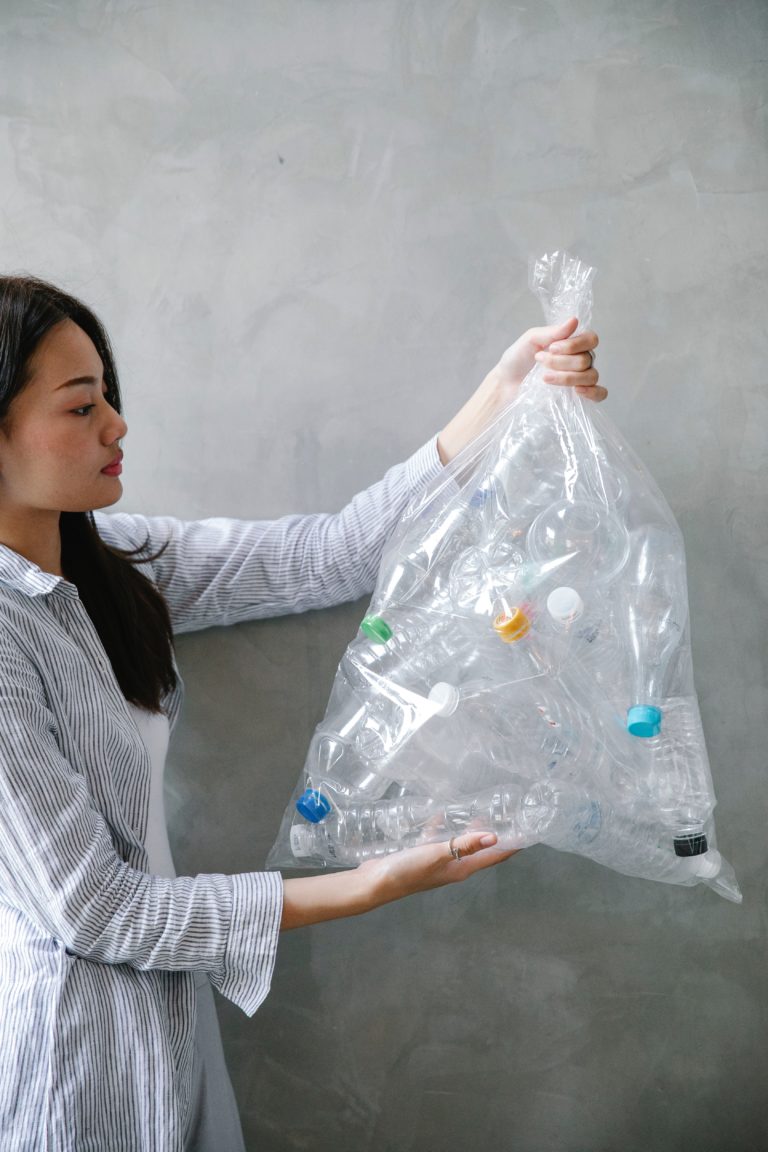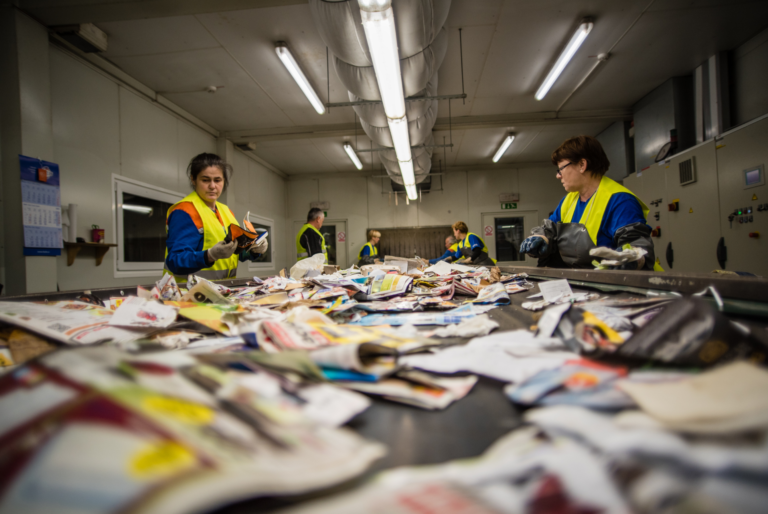Sustainability
Set up for Failure
How the Fragmented Approach to Recycling Fails Consumers and the Environment
November 2021
Uniformity Unlocks Recycling’s Potential
The dictionary definition of recyclable is a material capable of being adapted for a new use. But the simplicity of that definition branches in thousands of different directions in the real world. An easy answer today may be impossible; but getting to that answer is not only possible but capable of unlocking recycling’s potential.
Achieving uniformity in recycling definitions is the first and most critical step in the process of reimagining the American system — the true gateway to meaningful change.
Achieving uniformity in recycling definitions is the first and most critical step in the process of reimagining the American system — the true gateway to meaningful change.
Establishing uniform standards and definitions allow packaging to be designed for greater recyclability. They would create the ability to measure and manage recycling to boost recovered material. They would enable better decisions on where to make infrastructure and technology improvements to recycling facilities. They would provide for consistent and broad consumer education that will reduce contamination. And, perhaps most importantly, they will help determine where to target funding to ensure the money has the most meaningful impact — an impact that consumer packaged goods companies are willing and ready to invest in.
Unfortunately, today everything from the material a package is made of to where someone lives — plus state, county or municipal rules, even what month it is — can determine whether or which packaging can be put into a recycling bin. There are more than 9,800 recycling systems across the United States, according to the Environmental Protection Agency. And each has its own unique set of rules.
Recycling is in retreat. Cities and counties are reducing or even eliminating their recycling programs. The national recycling rate has stalled. Consumers are confused and frustrated. We cannot accept this disarray as our fate. Establishing uniformity is the change we need now to unlock recycling’s potential.
Key Takeaways

71% of Americans say having nearly 10,000 recycling systems creates confusion.

65% believe recycling rules should be the same nationwide.

Only 20% of Americans read their local recycling rules.
Recycling Matters to Environmental Improvement
Recycling matters to Americans.
In a recent Consumer Brands/Ipsos poll of more than 1,500 U.S. adults, those surveyed gave recycling an 8.3 on average when asked to rate its importance on a 10-point scale. And 84% said they were concerned about plastic and packaging waste, even higher than the 80% concerned about the environment in general.
Nonetheless, a 75% recycling rate is far from being realized. From a baseline of 6% of municipal solid waste recycled in 1960, it took 20 years for the U.S. recycling rate to reach 10%, even with the focus on the environment seen in the 1970s. The rate jumped dramatically in the 1990s and early 2000s and hit a peak of 35% from 2015 through 2017. At that point, the number not only plateaued but dropped to 32% in 2018, the latest year for which data is available. For plastic, the number is even worse — only 8% is recycled.
Packaging that could be recycled but is not contributes to a shortage for companies that want to use more recycled materials. There is currently only enough recyclable material to meet 6% of demand. That’s not just a depressing number — it is alarming as companies try to use more recycled materials both to deliver on their own promises and to comply with laws mandating recycled packaging that are multiplying across the country.
Why has recycling stagnated? For one thing, China — which gladly accepted multi-material waste for decades — restricted the import of most plastics and many other materials beginning in 2018. Partly because of that, municipalities that could once sell recyclables at a profit now have to pay to have them hauled away — and sometimes send them to a landfill or incinerator instead.
“The CPG industry has a need for recycled material without a recycling system capable of meeting the market,” said Consumer Brands Association President and CEO Geoff Freeman. “In what world do you have a massive market need and no one jumping in to capitalize on the opportunity?”
Foreign policy and recycled materials need do not have near-term solutions. But the establishment of uniform definitions can be solved for right now, yielding outcomes that positively affect the market.
Limited Faith in the Current System
Heightened concerns about recycling coincide with a time when local governments across the country have been forced to reduce or even eliminate recycling programs as the cost of recycling has increased, particularly the curbside pickup crucial to making recycling convenient for consumers.
85% of Americans would be upset if they found their recyclables were being landfilled or incinerated.
The fiscal imbalance of recycling is plaguing cities across the country. Just a few examples include: Bakersfield, Calif., went from making $25 a ton on recyclables to paying $75; Stamford, Conn., from making $95,000 a year to paying $700,000; and Washington, D.C., from making $1.4 million to paying $550,000 – and recycling there costs $30 more per ton than disposal. More than 100 communities have ended or suspended curbside recycling since 2018, most of them small towns but also cities of 100,000 or more like Jackson, Miss., and Shreveport, La.
The consequences of these changes could mean diminished faith in recycling that translates to less participation. Americans are already divided on whether the recycling system works. Only 39% surveyed for Consumer Brands say it works well, 36% say poorly and 23% don’t know.
Despite those mixed opinions, the public is clear that it wants its recyclables actually recycled. Some 85% of Americans say they would be upset if they found their recyclables were being landfilled or incinerated. A 2019 Consumer Brands report found that of the Americans who have seen their recycling programs cut or eliminated or watched recyclables to straight into a garbage truck, 63% said it made them want to stop recycling entirely — and not because they don’t care.
“We are on the clock to fix recycling before Americans’ faith erodes and frustration turns to apathy.”
Of those who admit they do not recycle, only 15% said they don’t recycle because they don’t care. In fact, people who don’t recycle say their biggest impediment is lack of easy access — 45% don’t have curbside recycling and 16% say it’s too far to drive to a drop-off point, too difficult to recycle or too confusing.
“Americans don’t know how well recycling works because the realities of the system are unseen by consumers who loyally place items in their curbside bins week after week,” said Freeman. “We are on the clock to fix recycling before their faith erodes and frustration turns to apathy.”
- 1960
- 1965
- 1970
- 1975
- 1980
- 1985
- 1990
- 1995
- 2000
- 2005
- 2010
- 2015
- 2016
- 2017
- 2018
- America’s Recycling Rate
- 6.4
- 6.2
- 6.6
- 7.3
- 9.6
- 10.1
- 16
- 25.7
- 28.5
- 31.4
- 34
- 34.7
- 34.9
- 35
- 32.1
Pervasive Confusion
What items are hard to recycle? With disparate definitions and rules, recycling isn’t easy. Of the 9,800 systems counted by the EPA, all create their own rules for what is recyclable and how materials are handled. And the Recycling Partnership points out that there are 20,000 incorporated municipalities across the country, with each making its own decisions on recycling — including whether to recycle at all.
Paper, cardboard, plastic bottles and metal cans are accepted most places that recycle, but Styrofoam or bubble wrap and plastic bags might be rejected elsewhere – and details vary everywhere. Some systems don’t accept glass bottles because they can break and jam sorting equipment. Some communities let residents put everything in one recycling bin while others require bottles, cans or paper to be separated, and cardboard or paper might need to be bundled and tied. Packages usually need to be rinsed and dry, and material contaminated by food waste usually isn’t allowed. The end result: Only 38% of consumers surveyed believe that all items marked with a recycling symbol can definitely be recycled in their community.
“We don’t let towns design different stop signs because we know it’s important that they are consistent and understood,” Freeman says. “Why should recycling rules be exempt from the same principle?”
Solving the 80% Problem
America needs recycling to work, partly because half of Americans say it would be difficult for their households to avoid single-use plastics for even a month. More than two-thirds (69%) say packaging that is difficult to recycle should be banned, yet 87% have purchased an item in a hard-to-recycle package recently while only 22% have used a refillable package.
There is a long way to go to make reusable and refillable options attractive for consumers in terms of convenience and cost. In the meantime, the Ellen MacArthur Foundation estimates that 20% of packaging could be replaced by reusable and refillable options. The idea of refillable containers is nothing new. In the United States, beer and soda routinely came in glass bottles that were returned to the store after use as recently as the 1970s, and the milkman picked up empties while dropping off full glass bottles.
Removing 20% of single-use packaging would have a significant impact but would still leave the vast majority in need of a recycling system that works. The U.S. needs to solve the 80% problem too.
Best estimates say 20% of packaging can be re-used or refilled. We still need to solve for the other 80%.
“The potential of refillable and reusable options is tremendous,” Freeman says. “Realizing that potential will require innovation that makes it convenient and affordable, areas the CPG industry is actively engaging.”
Industry companies are investing in creative, sustainable solutions that will reuse and reduce packaging waste. PepsiCo is scaling up its SodaStream business, which lets consumers make their own carbonated water with refillable bottles at home rather than buying single-use bottles of seltzer at the store. The move is part of a campaign to cut virgin plastic use per serving by half and to use 50% recycled content in all of PepsiCo’s plastic packaging by 2030. Procter & Gamble has teamed up with TerraCycle to provide its Pantene shampoo, Tide detergent and Crest Platinum mouthwash, among other products, in refillable bottles. Coca-Cola, Del Monte Foods, Colgate and Lamb Weston have announced innovations including soda bottles made from 100% recycled plastic, toothpaste tubes made from the same plastic as recyclable bottles, and plant-based packaging for fruits and vegetables — even packaging for frozen French fries made from potato starch byproducts created while making the fries.
Reusables and innovative packaging can go a long way to reducing waste — but they are not a silver bullet. The ongoing need for single-use packaging is the undeniable case for building a capable recycling system.
Uniform Rules Unlock Potential
The foundational step to fixing American recycling is achieving uniformity. Uniform standards and definitions unlock recycling’s potential in a meaningful way. Consistent ground rules mean that every stakeholder is focused on addressing the same problem, creating conditions to design the most recyclable packaging and to build recycling systems that accommodate that packaging.
Imagine being told to pack a suitcase without a destination. That is recycling today — an educated guess without a consistent framework.
Imagine being told to pack a suitcase without knowing the destination. Some of the items in the suitcase may work but some will stay unused because its contents are only an educated guess. That is recycling today — an educated guess without a consistent framework.
Consider the hoops consumers have to go through to understand what is recyclable in their local area. In Fairfax County, Va., for example, there are 13 private companies that handle residential pickup in addition to the county itself, which collects from only about 10% of residents. To determine what can be recycled, the county can only offer general guidelines, telling residents with private collection to ask the company responsible for their pickup for specifics. That leaves 14 possibilities within one county.
A report from the Environmental Research and Education Foundation found that there are at least 18 distinct ways that recycling is defined at the federal level alone, and that 49 of the 50 states each have their own definition of recycling (the only exception being North Dakota, which the study was unable to find a definition for).
Confusion is worsened by initiatives such as a new California law that creates stringent criteria for what products can use the “chasing arrows” recycling symbol. Reflecting the complexity of the state’s localized recycling system, the law forbids the use of the symbol — and the use of plastic resin codes within the symbol — unless the packaging or container can be recycled in at least 60% of California communities, even if an item could be recycled in some areas of the state. It ignores that the plastic resin codes are not intended for consumers but for recycling processors to sort material. And it also ignores the fact that the codes are required by law in at least a dozen other states, effectively requiring manufacturers to provide different packaging just for California.
The need for uniformity is more important with the ongoing proliferation of state laws on recycling.
In the past year, several states have either passed or proposed legislation creating targets for increasing the use of recycled materials in consumer goods packaging. California, for example, enacted legislation this year that will require glass and plastic packaging to include 50% recycled content by 2030 and the state of Washington passed a bill requiring most beverage containers and packaging for household cleaning products and personal care items to be made with 50% recycled content by 2031.
“Recycling has potential to have a greater environmental impact if we allow it to — but right now, all we are allowing is failure.”
Maine and Oregon this year enacted the nation’s first two extended producer responsibility laws, requiring packaging producers to contribute to recycling costs, and Oregon’s version sets plastic recycling goals of 50% by 2040 and 70% by 2050. (Maine already had a 50% goal on the books.)
Legislation pending in New Jersey would eventually require 50% recycled content for plastic beverage containers. Those numbers cannot be achieved if recycling rates continue to flatline and sweeping changes aren’t made to fix the broken system.
“These are admirable targets that we must work to meet, but we can’t expect results if we don’t fix what’s broken,” Consumer Brands President and CEO Geoff Freeman says. “Recycling has potential to have a greater environmental impact if we allow it to — but right now, all we are allowing is failure.”
State and Federal Officials Need to Coordinate
Getting to uniform standards and definitions is fundamental but not simple. There are additional policy issues that create further complications.
Many of the new state mandates for increased use of post-consumer recycled content in packaging apply to packaging for food. But regardless of state laws, it’s the Food and Drug Administration that has regulatory oversight of recycled content in food packaging — which poses the risk of a supply chain bottleneck as more companies look to use new forms of recycled content that have yet to be approved. Recycled materials for food-contact packaging must meet the same FDA stringent standards as virgin materials, meaning if a food manufacturer wants to use recycled plastic it must submit a complete description of the recycling process, steps taken to ensure the material is not contaminated at any point in the process and results of tests performed to prove possible contaminants are removed. The FDA review process can take months and comes only after companies have taken years to develop new food-contact materials.
Food and product safety are a top priority for both CPG companies and the FDA. While our industry is making progress on more environmentally friendly packaging — partially by using more recycled content — we need to work closely with federal regulators and lawmakers to create a system that benefits everyone. Consumers Brands brought CPG companies and the FDA together this summer for a listening session where we asked the agency to update its 15-year-old guidance on food-contact packaging and offered thoughts on innovations in packaging with recycled content.
In addition, the FTC is working to update its Green Guides, which provide non-binding but important guidance on the use of terms such as recyclable, reusable and biodegradable, for the first time in nearly a decade. The FTC’s interest is in ensuring that claims made by companies using such terms are not misleading or deceptive. But in the absence of other official federal definitions, the Green Guides could see new importance as either the federal government or states pass laws or regulations that depend on consistent definitions. Accordingly, Consumer Brands earlier this year formed a new Sustainability Claims Task Force, which is examining terms the FTC should update and new terms like “sustainable” that should be added.
Industry is Calling on Government to Engage
Consumer Brands has called for national standards in its Recycling Policy Platform, saying they would provide clarity to consumers, manufacturers and waste management that could facilitate the highest possible rates of recycling. Consumer Brands believes recyclable packaging should be able to be recycled regardless of geographic location or whether it is in a single-family home, apartment or office building. What is recyclable in one place should be recyclable in another.
In addition, the Recycling Leadership Council led by Consumer Brands has called on the federal government to direct the EPA, in coordination with other agencies, to establish a single national definition for the terms “recycling” and “recyclable.” The definitions should then be used and standardized across all agencies, including the Federal Trade Commission and the Food and Drug Administration.
The RLC has also called for the EPA to create a best practices framework, including minimum recycling rates at the state level based on the agency’s goal of a national recycling rate of 50% by 2030. Standardized recycling programs should also be established throughout federal government domestic operations down to the color of recycling and waste bins. Standardization should include public-facing government operations such as national parks.
Fortunately, efforts to standardize definitions are beginning to be seen. Near the end of 2020, the EPA announced its National Recycling Goal, which includes establishing “standardized definitions for the recycling industry to keep pace with today’s diverse and changing waste system.” Without uniformity, “We know most people want to recycle, but there’s confusion about what can be put in the bin,” the EPA says.
“We need to move beyond goals and toward action,” said Freeman. “It is past time for EPA to put forward standards that are clear and meaningful. It is my hope that by America Recycles Day 2022, we have uniformity and are moving to implement changes accordingly.”
Until rules and definitions are standardized, it won’t be possible to capitalize on the full potential of recycling. And not aiming for better today means risking momentum and denying recycling the robust system it desperately needs now and for the future.
A World Without Recycling?
Allowing the recycling system to deteriorate has downstream consequences beyond the obvious. Without recycling, the United States would not only be contending with more trash but would face intensified environmental challenges.
Without recycling, the United States would face intensified environmental challenges. It is an untenable outcome — not an inevitable one.
As Recycle Across America Founder and Executive Director Mitch Hedlund told the New York Times, the absence of recycling would lead to “more oil drilled, more trees harvested, more fresh water and energy used, more materials littered, more waste in oceans, more carbon dioxide emitted” with “otherwise valuable recyclable commodities … buried in landfills or burned.”
It is an untenable outcome — not an inevitable one. Recycling is at an inflection point that presents a tremendous opportunity to rethink the U.S. system for the 21st century. The CPG industry has emphasized support of national solutions that have sufficient scale to protect the environment and address underlying problems.
Real and lasting improvements are possible — but only if we address the fundamental failures plaguing this fragmented system. There is no greater failure than a fragmented, confusing system. And no clearer remedy than uniform standards.
Methodology
This report is informed by a Consumer Brands/Ipsos poll, conducted June 30 – July 9, 2021, by Ipsos using the probability-based KnowledgePanel. This poll is based on a nationally representative probability sample of 1,530 general population adults aged 18 or older. The margin of sampling error is plus or minus 3.2 percentage points at the 95% confidence level.
Read More

Blog
Bette Midler Changed My View of the Environment

From the News
The EPA Wants to Fix U.S. Recycling. Start by Making it Simpler.


